Trans Inclusion Part 2: Will Women Have All Lanes That Life & Rights Promise Them By The Time Regulators Are Done Deciding?
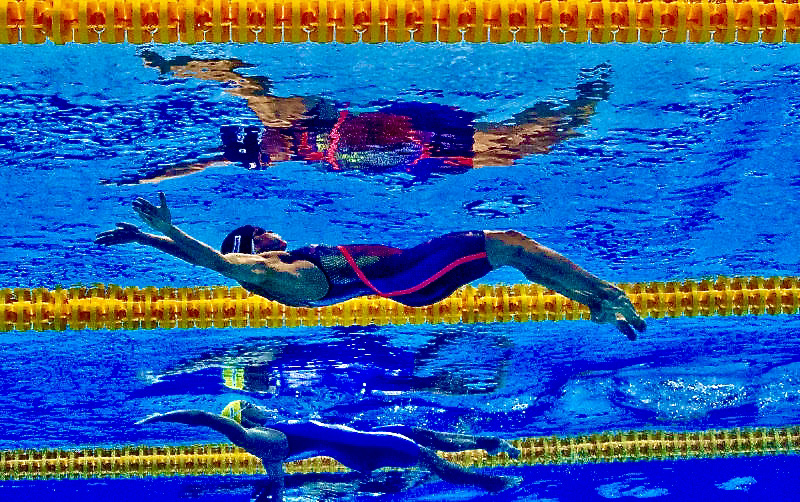
SOS Weekend Essay – The flag of rights in hand, Nancy Hogshead-Makar sails the good ship Pygmalion as she tears metaphorical pages from the 11,995 lines and 15 books that make up Ovid‘s narrative poem Metamorphoses and nails them to the mast of swimming, a sport in a maelstrom, barrels of discrimination leaking into a sea of women’s sport hard fought over.
In part 1 of our interview with Nancy, we heard her tell girls and women: “Fight Or Resign Yourself To Sexism & How That Plays Out In Women’s Sport”.
In part 2, we hone in on key contents of the repair kit and the design of the rescue boat required to guide women’s swimming back to a safe haven and the sport as a whole back to peace.
Where the scape, scope and stakes of the subject are as high as the waves in the storm, it’s helpful to hone in on five key elements of Nancy’s campaign to save women’s sports from crashing on the rocks of regulatory malaise:
- The law and rights of women in sport
- The policy and the petition
- Silencing omen & treating rights & respect as a one-way street
- The might of men & women
- The sea-worthiness of the rescue boat being built
1. The law and rights of women in sport
If in the following long read there are two quotes from many that hone in on the fight for women’s rights in sport, these are they:
- “It is our sports. We created them. We’ve given up our entire our professional careers to be able to have women’s sports to have women celebrated, to have everybody know who Katie Ledecky is and who Missy Franklin is. We’ve done that. And to have our voice excluded from this conversation is criminal.”
- “… we know about these huge gaps between men and women and the numbers of opportunities women are missing out on and how they add up to a billion dollars a year, just because they’re women. So, right now, 18 to 22 year old, women can go in front of a judge and get all that changed. If anybody out there wants to come reach out to me, you can get that changed in front of a judge. If it’s [the policies and rules of regulators] all based on ideology, we lose the category; we lose the Right, capital R, the Right to that category. And that’s my [biggest] worry, right there.”
Before placing those words in context, worth noting that Nancy has been asking women to reach out to her for legal guidance for decades, her championing of women’s rights in sport, from sexual abuse to Title IX, equality and equity named in the title of the organisation she founded, Champion Women – bracket, what does the law say, what can we take before a judge, end brackets.
On the matter of how to balance the essential Fair Play and rights that women’s sport would be lost without with the inclusion of transgender athletes in sport, the advocate and legal eagle is blunt when it comes to dealing with versions of inclusion that extend to invasion, discrimination and loss of rights for women and the way the law is constructed on foundations of fact not ideology. She says:
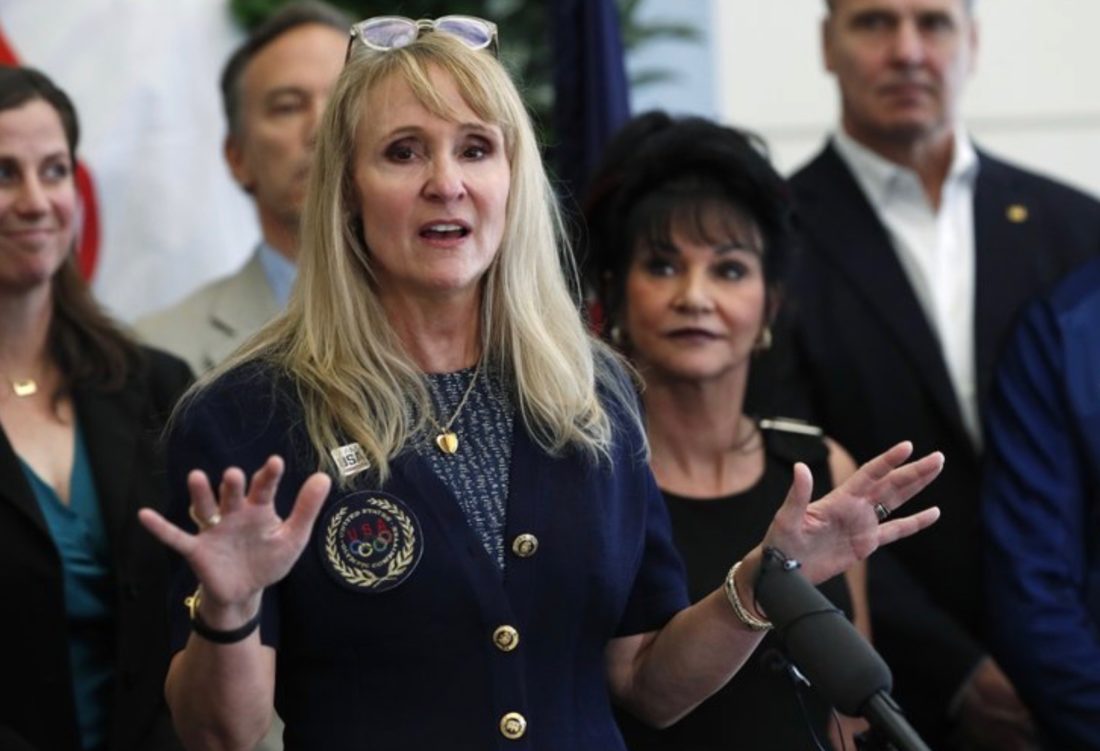
“So, what’s at stake here? Ok, there are things I don’t know. I rely on scientists; I read what scientists have to say, but I am not a scientist. I’m a civil rights lawyer so the part that I know really well is that we have sex segregation in sport. That is unlike anything else in the world. We don’t segregate employment. We don’t segregate the classroom. We don’t segregate all other places where we disallow sex segregation throughout society, right? Restrooms we segregate for reasons of privacy and modesty but we segregate sport for a very different reason. We segregate sport because of biology – and most people don’t understand just how big the gaps are between men and women.
Michael Phelps has got a 0.2-point advantage over his competitors [average across a range of events]. Then there’s Katie Ledecky, the world’s greatest woman swimmer. She’s 2 per cent better than her competitors, which is amazing. To have somebody be two whole percentage points ahead of the opposition is amazing and reflects just how great she is. But then look at the gaps between men and women: they are roughly 11.5 per cent in swimming. It’s a little more in the sprints, a little less on distance.”
Nancy Hogshead Makar – image courtesy of Champion Women
The basic ground work on rights set, Nancy notes the nature of the world we live in, the nature of men (women, too but the history of decision-making in sport has been a tribute band bashing out the James Brown classic on replay), men like those who sat around a table in the 1960s and decided that what East Germany needed to show how good its ‘democratic republic’ was success in sport and the fastest way to achieve that was to lend girls male advantage by fuelling them with testosterone-boosting substances.
The Sporting Crime of the 21st Century ensued and its impact lives on to this day as guardians and stewards of Olympic sport, still largely a club of men, continue to turn a wilful blind eye. Says Nancy:

“So, when somebody comes along, let’s say somebody who hates Title IX and hates women in sports and don’t believe women have the right to equality – I don’t think this would necessarily come from the trans folks, but but they’re out there and we both know it – and they go in front of a judge and they try to say that this ideology of trans identification is what makes the distinction between men’s and women’s sports, and that categorisation is not based on biology but identity, what does the judge do?”
Nancy Hogshead-Makar
Noting that her own husband is an appellate court judge, Nancy adds: “A judge cannot affirm sex segregation based on an ideology of gender. It has to be based on facts, on science, on biology, in order to maintain rights. So, do I think women’s sports would disappear because of transgender inclusion? No. I think a lot of schools would still continue with their sports programming but we have to ask whether women would have the right to equality.”
She turns to Sedona Prince, the Oregon Ducks basketball star who made headlines after revealing the difference between the NCAA women’s and men’s weight rooms and facilities during March Madness last year. Here’s Sedona speaking to GMA about the issues she sent viral and the NCAA response saying that the reason the men had massive facilities worth vast sums of money and the women had the Ikea flat pack version of a mini stack of weights was not a money issue, nor about rights, but a problem of space (as if we were all born yesterday):
Says Nancy: “So when Sedona Prince said … ‘here’s the women’s weight room … and … here’s the men’s weight room’, the question is … could you get those women in front of a judge and say ‘Judge! Make them behave!’? You could not. You don’t have that right. So if a school hypothetically wanted to say ‘we’re not going to offer any women sports’ – I don’t think that they could from a political standpoint because you’ve got parents and others there – they could.
“But … we know about these huge gaps between men and women and the numbers of opportunities women are missing out on and how they add up to a billion dollars a year, just because they’re women.”
She adds: “So, right now, 18 to 22 year old, women can go in front of a judge and get all that changed. If anybody out there wants to come reach out to me, you can get that changed in front of a judge. If it’s [the policies and rules of regulators] all based on ideology, we lose the category; we lose the Right, capital R, the Right to that category. And that’s my [biggest] worry, right there.”
As a civil rights lawyers helping women in sport, she notes: “I’ve never met a single female athlete that couldn’t list the ways they’re getting second-class treatment as compared to their male football or basketball players. Over the past four decades, she adds, “the unwritten rule [in U.S. College sport] is that women’s sports can exist, so long as not a single male is harmed by women’s inclusion. Yet now, women are expected to graciously roll over and let trans athlete-inclusion change the what the women’s sports category means, what rights it conveys. Do we hear men’s outrage?”
A petition shows that many men are indeed willing to back the campaign to save women’s sport for women while finding ways to include transgender athletes in sport.
2. The policy and the petition

When a twin policy and petition attracts a Who’s Who of swimming names, including more than 300 elite athletes, among them many legends of the sport, regulators surely know which way the wind is blowing and can more easily set aside the societal and political debates related to the issue of transgender inclusion and focus on the impact that their own policies and rules are likely to have on the very community they regulate and are answerable to.
Though there are aspects of the following that not all of those signing are 100% comfortable with, there is no doubt about the exceptionally strong support for the campaign of the Women’s Sports Policy Working Group and Champion Women.
Examples of where there is a difference of opinion among people who agree with the direction of travel signposted by the WSPWG model legislation and Champion Women petition include child gender transition, one of the great dividers of opinion, a subject that is not covered by moves designed to protect elite women’s sport but not necessarily the birthing pools of sport in the community, at schools and similar places when young people develop their skills.
You can read the details of the model legislation and petitions, which is still open for those who wish to sign, here:
- The Women’s Sports Policy Working Group positions and model legislation
- The ChampionWomen.com petition
The Champion Women petition was a precursor to the latest USA Swimming inclusion policy (see point 5 below), while the Women’s Sports Policy Working Group positions and model legislation includes these key references at the heart of debate that Nancy and picked up by Nancy raises above in reference to the law:
In the unlikely event that sports were to be completely redesigned, to be segregated based on some objective physical criteria other than biological sex, e.g., height, weight, bone size, lung size, or wingspan, males would dominate these new categories. Only biological sex-categories can guarantee females a fair playing field in competitive sports. In other words, females cannot overcome this performance gap with more talent or training, better coaching, facilities, or nutrition.
The WSPWG’s policy position is that sport leaders should work cooperatively to fashion rules so that transgender girls and women are fully welcome into sport. Their sport performances should be respected in girls’ and women’s competitive sports if they are separately scored OR if they can demonstrate that their male post-puberty advantage has been sufficiently mitigated. Similar separate scoring based on performance advantages are already fully accepted in sports, such as age categories, or weight categories in wrestling, rowing, and weightlifting, etc.
The paper explains why sport is sex-segregated and why is sex-segregation in sport lawful, while sex-segregation in the workforce is illegal sex discrimination.
3. Silencing Women & Treating Respect & Rights
As A One-Way Street
Returning to the situation in which regulators allowed the Lia Thomas saga to unfold in the way it did in an NCAA season this year marked by a toxic environment and “Save Women’s Sports” protests outside of the competition venue, booing and cries of “shame on the NCAA” inside the venue, I suggest to Nancy that governance failure is to blame for the crisis, discrimination and loss of rights.
From afar, I assume NCAA leaders just don’t understand the nature of performance sport (and if not, how to regulate it in appropriate fashion?). I assume they just don’t know the subject they regulate. Nancy rejects that particular excuse. She says:
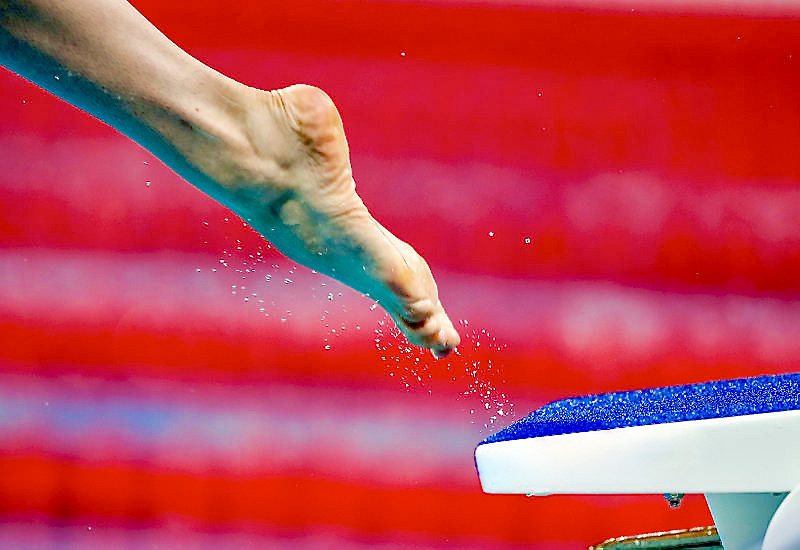
“It’s not that they don’t know, its’ that they don’t respect, they don’t respect women sports’. They are perfectly happy to take that position. The Ivy League, every one of these NCAA schools told these biological women athletes to be quiet.”
Nancy Hogshead-Makar – Image: red warning on the water, by Patrick B. Kraemer
To reinforce the “shut up and put up” message, the boards and backdrops to the saga included giant images with mantras like “Eight Against Hate”, which someone with a budget must have funded in the season that followed Sedona Prince highlighting the discriminatory way in which women athletes are discriminated against at U.S. colleges. Says Nancy:
“It was all about, having a mission statement that “we’re not transgender phobic”, ignoring the fact that you can be trans loving and trans appreciative and still think having trans athletes who grew to be men before transition is unfair. You want the best for them and at the same time think it’s just not fair. Those two things are not are not in opposition with each other.”
Is it fair to suggest that policy decisions at the NCAA have prioritised societal mores over the nature of performance sport and fairness for women?
“Correct,” says Nancy. “And then they’ve created an environment where women cannot speak out.”
A self-harming act in that hidden threats are like the seed of weed in spring: they’ll find the light. Then there’s this: “Hopefully the petition will break the dam for people who think they can’t speak out. You have some of the best athletes and coaches in swimming history”, letting their voices be heard,” says Nancy.
In that sense, Champion Women’s petition sparks the NCAA negative with the powerful positive of thousands of athletes and thousands more signing up to the opposite of what the NCAA and Ivy League schools thought they might get away with when telling women athletes to toe the line, regardless of their rights.
“Every single Olympian and Paralympian who signed was ok with their names being published,”says Nancy, noting that provision was made for the minority who were supportive but wished top sign without having their names published.
Besides that, there are always those willing to come forward and get the truth out on condition of anonymity:
The silencing of women is particularly pernicious in that such experience is rare among men when injustice or cheating rears its head in men’s sport. “I mean the trees that are lost as a result of ‘deflategate’, right?
She mentions a couple of other cheating scandals from men’s sports and notes the wave of coverage involving everybody weighing in and able to exercise their right to free speech. Overlaying that with the women’s swimming saga, Nancy asks, rhetorically: “ If it turned out hypothetically that a trans woman on performance-enhancing drugs actually outperformed what the men were doing, do you really think that men would be like ‘sure come and take those gold medals.”
I ask the triple Olympic gold medallist what she felt like about even having to take this issue on after all the decades of work on building women’s rights in sport, in playing a key role in getting legislation passed on Title IX and the Empowering Olympic, Paralympic, and Amateur Athlete Act (S2330)?
“I really feel for the athletes,” says Nancy, noting the letter she worked on with Penn athletes and parents and the Ivy League swimmer who came forward to speak on camera. There was a much misunderstood or under-appreciated “Quantum Leap” between men and women in sports such as swimming. Transgender inclusion of boys who are to be men before transition simply ignored those truly significant margins.
As sports scientist Ross Tucker noted in the wake of Lia Thomas becoming the first transgender swimmer ever to claim an NCAA Championship title when finishing first in the 500 yards freestyle on Thursday:
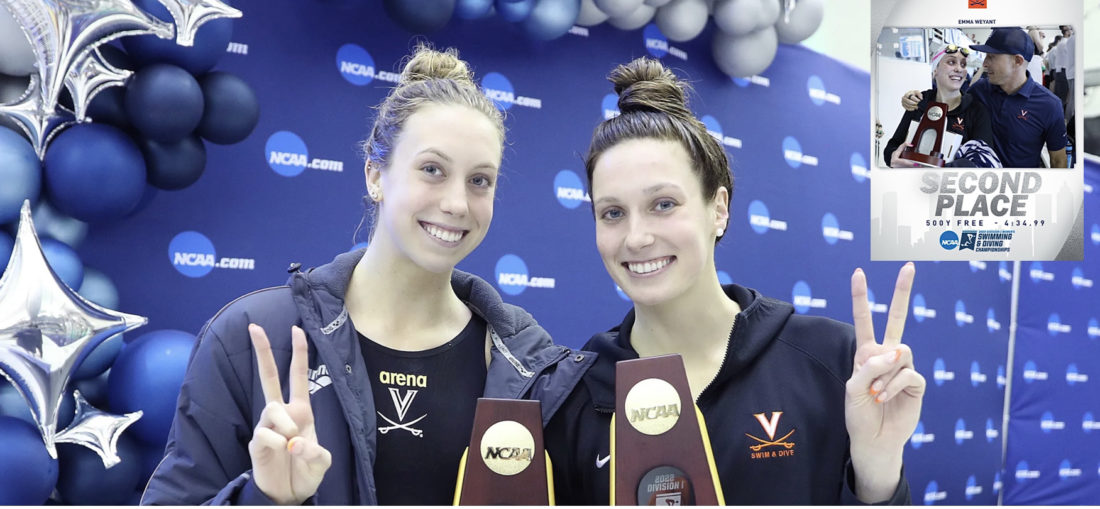
“For years, people knew that this could (and would) happen. All it would take is for a relatively decent male to be the case. Not at Hubbard level, but a little better. Someone 3% slower than the best men, rather than 10% slower. Close enough to parlay advantage into this result.
“Still, the stupid counter argument “they’re not winning, so where’s the advantage?” was bandied about. So if there’s a good thing from this, it’s that people will no longer be fooled by that sleight of hand. We now know & see, and many more people are aware of what is happening.
“And of course, “what is happening” is that women, not men, are not only being asked to step aside to allow men into a category that is necessarily and rationally closed to male physiological advantage, but to accept this, and then also to celebrate it. It’s a travesty for them.”
Ross Tucker – image: The Walsh sisters, Gretchen, left, and Alex, NCAA champions for Virginia, and Emma Weyant, inset, and head coach Todd Desorbo, celebrating the women’s gold in the open 500 yards free
Nancy notes: “Even if they don’t win, they’re still taking places from women that really deserve to be there, who have worked really, really hard. So we’re talking the top 10,000th woman in swimming who is training 20 hours a week, who is getting up early in the morning and going to workouts and who has been lifting weights has the right to a place.
“Maybe she’s a division, 3 swimmer and she has the right to be there, she has the right to win among women on that day. That’s why we created the category. She has rights. We have to think about the person who didn’t get to go to the NCAAs, the person who didn’t make the Penn team because they can only take 18 [to the championships] … that person is being discriminated against because they’re female.”
With her legal hat on, she laments: “We were not successful in getting these women to sue. We can’t even get them to speak out. I respect that, I understand. I’m not making them wrong because they can’t speak out. And hopefully that’s what our petition will do: allow them to be able to speak up, understand their rights. This is sex discrimination. Make no mistake about it.”
4. The Might Of Men & Women
There are many angles and measure on assessing the might of men versus the might of women in sports such as swimming, including this exceptional explanation from Ross Tucker on why leaving the matter of transgender inclusion to testosterone suppression for this wanting to race among women is woefully shy of what would be required to deliver fairness.
Among resources is a website called biysvswomen, which compares performances of Male High School Athletes to those of Female Olympians and asks: If boys win against the fastest women, is it fair for males to compete in female-only athletic events?
The trail of much significant science and the changing narrative of transgender inclusion down the years is well told by Dr Emma Hilton. Her 2020 research on transgender women athletes with Tommy Lundberg concluded:
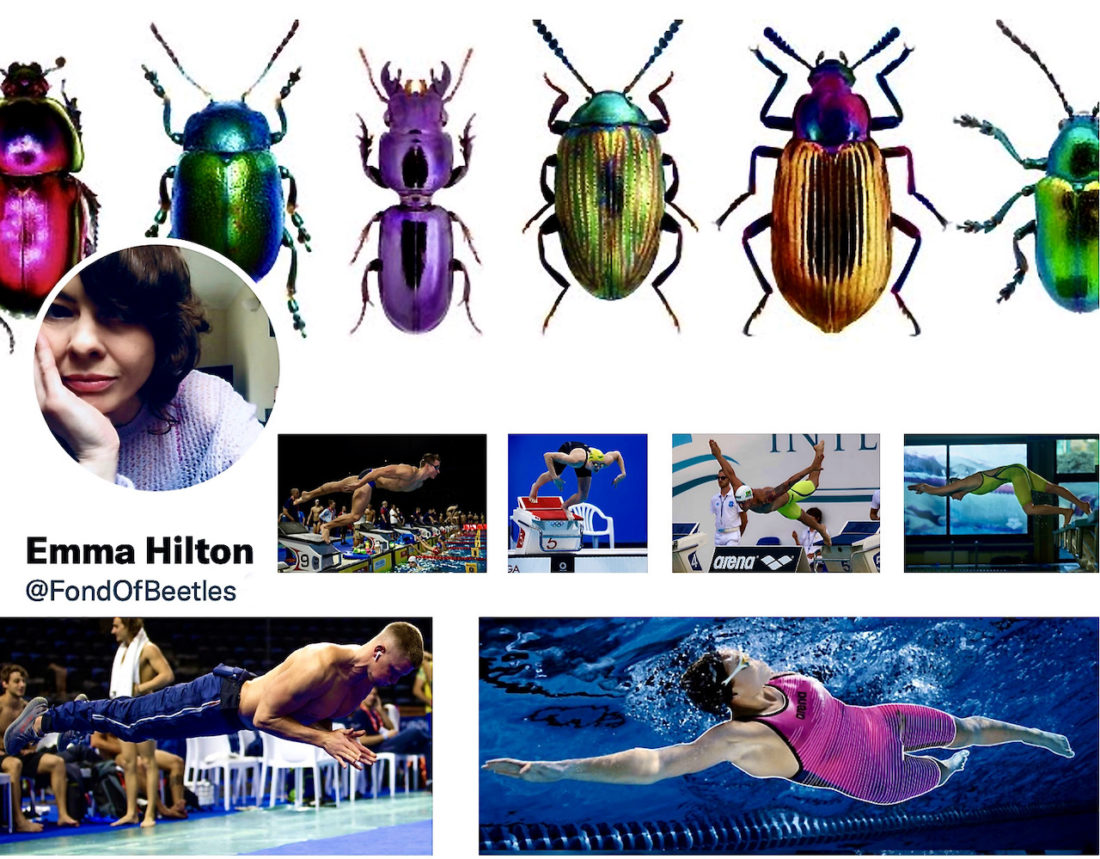
“The biological advantage, most notably in terms of muscle mass and strength, conferred by male puberty and thus enjoyed by most transgender women is only minimally reduced when testosterone is suppressed as per current sporting guidelines for transgender athletes.”
Image: Dr. Emma Hilton is fond of beetles – and safeguarding women’s sport for biological women, too – image, Emma Hilton Twitter profile and various other beasts, airborne and aquatic (swimmer images, Adam Peaty and Ben Proud by Patrick B. Kraemer; Cate Campbell, courtesy of Swimming Australia; Bruno Fratus, Hannah Miley and Ranomi Kromowidjojo, courtesy of Arena)
Nancy Hogshead-Makar points to some of that science and then notes some of the ways in which it shows through, including some myth-busting measures aimed at those who take Phelps and falsely hold him up as an example of the extremes on the spectrum of human capacity and asks us to conclude ‘so, just let anything be because all of it is unfair in a fair sort of way’:
- The average differential in the men’s and women’s ‘A’ standard times for NCAA championship qualification is 11.41%; meaning the women’s times are 11%+ slower than the men’s qualification times.
- About the same differential occurs if you’re looking at almost any group of swimming records or qualification times between men and women, including regional or USA Swimming qualification times, American records, world records, NCAA records.
- Olympic superstar Michael Phelps held just a .08% of an advantage over his U.S. teammate and rival Ian Crocker in the 100 butterfly in the 2004 Olympics.
- Phelps held a 12.62% advantage over Australian Petria Thomas, the women’s champion in the same event.
- Phelps’ advantage over women equates to over 150 times more than the advantage that Phelps had over his male competitors.
- Had Phelps enjoyed a 12.62% over the other blokes, he would have won the Olympic gold in a time 6.47secs faster, or 44.78 seconds, way faster than any man has ever got close to on freestyle.
- Lia Thomas is is just 2.6% (not 11%) slower than pre-transition in the 200y freestyle and just 5.76% slower in the 500y freestyle .
5. The sea-worthiness of the rescue boat being built
USA Swimming has its new policy in place and FINA will soon reveal what it has been working on but is the rescue boat fit to save women’s sport and rights? Will it, for example, be able to cope with the rogues in sport we all know have long been out there doing harm through various forms of abuse, many of which involve harm to teenage girls. So, can a system that involves doctors and expert panels and form filling and evident taking mitigate for the presence ion international governance of, well, ‘bad folk”? How do we ensure that the doctors in solved in doping young Chinese kids are nowhere near the process? How do we ensure that Dr. Lothar Kipke never happens again?
Says Nancy: “So, USA swimming created a two-step process and why that was so good is that the first step is that the transgender person has got to show that they don’t have an unfair advantage. I don’t know how the post-puberty person can overcome that. So forget about nano-moles and testing and being able to show that certificate and everything else. Unless someone transitions pre-puberty, I don’t know how you would get round that.”
“The reason why we stopped using the sex test where they tested the cheeks was because of a condition called Androgen Insensitivity Syndrome,” she adds. “So AIS is where somebody with XY chromosomes has testes, not ovaries. They produce testosterone in the male range, but it’s not bioavailable. So when you look at someone with AIS, they usually have longer limbs and they they look nothing like me, really muscular. There’s no reason not to include them in the women’s category.
On the controversial issue of pre-puberty transition, Nancy says: “I’m not going to make a value statement as to whether I agree or, I don’t agree with somebody transitioning pre-puberty, but if they do, and they don’t go through male puberty, then they’re just like somebody who has AIS and they might be able to show that they that they can compete in the women’s category.”
The Champion Women petition was drawn up as a precursor to USA Swimming’s new Athlete Inclusion, Competitive Equity and Eligibility Policy, a policy of rights that states this from the get go:
Purpose: The USA Swimming Athlete Inclusion, Competitive Equity, and Eligibility Policy (this “Policy”) is based on the objectives of inclusion, non-discrimination, fair play, participants’ health and safety, and protection of privacy.
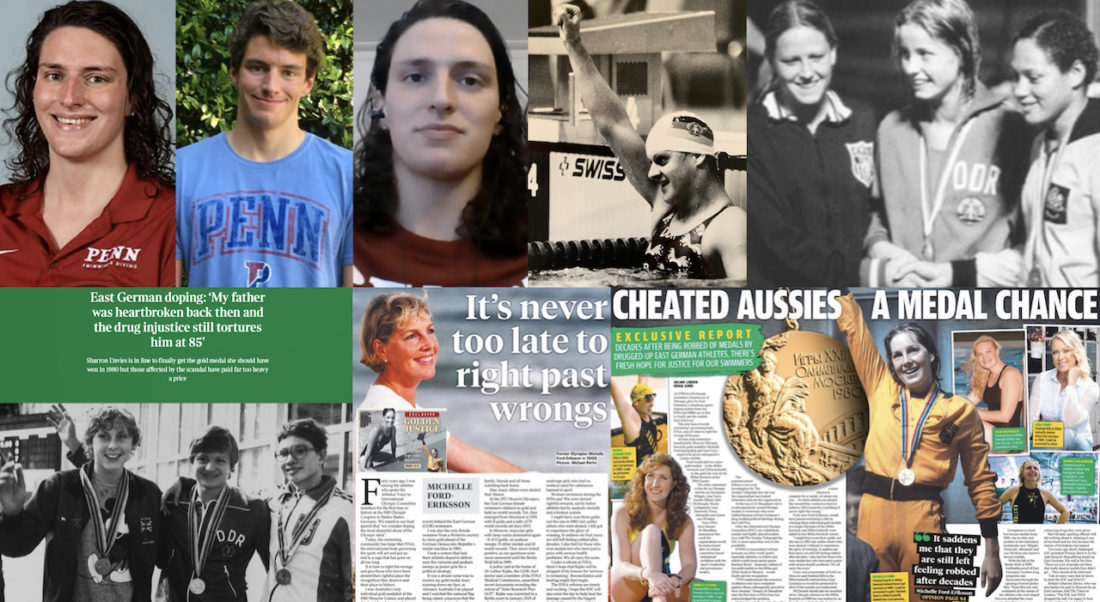
The six pages of details describing what that means ought to be read by all in swimming. FINA is likely to travel in a similar direction, having helped USA Swimming get its policy out in time to have an impact on the NCAA Championships. That plan did not work for this season but may mean that transgender women will not feature in women’s college swimming competition in years to come in the same way as Lia Thomas has this year.
The USA Swimming policy is comprehensive in its description of ‘elite’, basically covering everyone who is eligible to break an American age record from the age of 13 upwards and anyone who enters a competition at which they can set a qualification time to enter any level of ‘elite’ event as described in the policy.
Processes for transition rights are set out from self-verification to a “Fairness Evaluation” designed “to ensure that athletes competing in the Female competition category who have transitioned from a Male biological gender assignment at birth, do not have an unfair advantage over their cisgender Female competitors in Elite Events”.
The process would include this: “… a panel consisting of three independent medical experts, with preference for experience related to transgender health and/or the physical performance of transgender athletes relevant to swimming and the effect of medical approaches in mitigating any pre-existing physical advantages”; and before there is any need to monitor testosterone suppression within parameters set out in the policy, any wishing to transition from male to female and be eligible to race among women would have to comply with this high bar:
As a condition of eligibility, the athlete must satisfy the Elite Athlete/Event Fairness Panel that:
(i) From a medical perspective, the prior physical development of the athlete as a Male, as mitigated by any medical intervention, does not give the athlete a competitive advantage over the athlete’s cisgender Female competitors.
And anyone who wishes to engage with the process must agree to there being no time limit on assessments in these terms: “The athlete will acknowledge that this evaluation process is complicated and agrees that neither USA Swimming or members of the Elite Athlete/Event Fairness Panel shall be liable for any detriment caused the athlete by delays in the evaluation process.”
Should an application be approved, the transgender athlete wishing to race among women would have to have testosterone levels monitored for the rest of their racing days, as in “the athlete must keep the athlete’s serum testosterone concentration below 5 nmol/L and comply with any other conditions of the Elite Athlete/Event Fairness Panel’s approval for so long as the athlete wishes to compete in the Female category in Elite Events”.
That measure of 5 is controversial because the average range for biological women is 0.5 to 2.4 nmol/L. A good explanation of why ‘5’ has been chosen as a reasonable measure can be read in this 2019 paper from the European Society of Endocrinology, which includes:
“Levels in healthy men are in the range 7.7 to 29.4 nmol/L and 0 to 1.7 nmol/L in healthy women, so for fairness and considering the over-representation of women with naturally higher levels in sport, the IAAF recently formulated new regulations and defined a maximum testosterone level of 5.0 nmol/L for eligibility in the female classification of middle distance track disciplines. The Court of Arbitration for Sport approved the IAAF’s regulations on 1 May 2019. Prof Hirschberg says, “Sporting success should come from a combination of talent and dedication. In circumstances where women have 10 to 20 times higher testosterone levels than normal they may have a powerful advantage. Elite female athletes want to compete fairly against other women. However, we must also appreciate that drawing a line on an acceptable level is difficult, our recommended limit makes allowances for women with mild conditions like PCOS (Polycystic ovary syndrome), whilst ruling out those with more severe conditions that hugely increase testosterone levels and promote a more male-like physiology … In the interests of fairness in sport for all women, a policy that responds with sensitivity to those who may have a condition causing high testosterone is needed. We have focused specifically on defining the levels that really confer additional advantages on physical performance, and recommended an appropriate limit for competitive fairness.”
“To have our voice excluded from this conversation is criminal” – Nancy Hogshead-Makar
Our interview draws to an end. We talk about the hate levelled at J.K. Rowling for raising legitimate rights issues, the false accusations of “Nazi, white supremacist, racist” and much else aimed at those who do not agree with transgender athletes grown from boys to men before transition competing with women. Nancy urges a better level of discourse and notes:

“Until we can have this be a factual debate and get words like transphobia and trans hate out of there, until we can talk about what really is fair; ask ‘how can we reshape sport, assuming goodwill’. We want to include everybody in sport. If anybody knows how important sports is to somebody’s lifetime achievement, it is women because we have gone from zero and we know that sports participation is the only after-school activity that out-predicts what somebody would normally achieve.”
Nancy Hogshead Makar (courtesy of Champion Women)
She adds: “There’s a predicted rate based on how much education your parents have, how much household income you have, what your zip (post) code is etc. So, being in the Debate Club, being in student government, being in the band, doesn’t do it. People who do sports out-predict on every metric. They stay in the workforce, are much more likely to be leaders in the work place. So we know how important this is and women would never want to come up with a system where transgender people are excluded from this amazing thing. Just like we had to really change the rules when it came to creating Paralympic opportunities because schools didn’t have enough wheelchair basketball kids to be able to form a team, let alone compete with other teams. You want to create these opportunities and there’s no reason not to have them but at the same time, different sports are very different. In swimming, come on, to have one more heat or to have one more person in a men’s or women’s lane and have another category? Why can’t we do that?”
Her message is clear: it’s not that hard.
One last question. Was she asked for her experience and knowledge rights and more to feed into the FINA process of forming new inclusion and fairness policy?
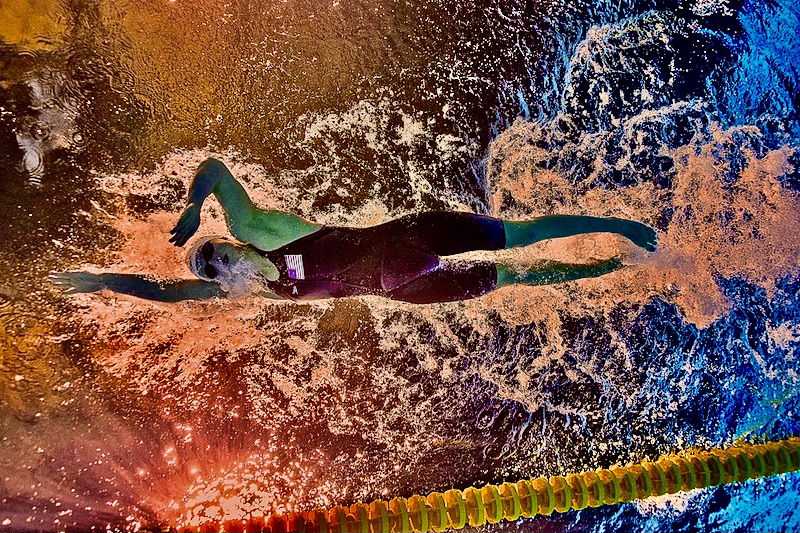
“That is a great question. All the current rules specifically excluded Cis women. I have an email from a trans advocate who says “make sure not to include biological women because they’re all transphobic” . So in other words, women did not have a seat at the table when they were cutting up our position. So you had trans advocates there, you had the men who were making the decisions.
So we are are now getting together with a broad International Group to make sure that for every International Federation, like FINA, we have a seat at the table. It is our sports. We created them.
We’ve given up our entire our professional careers to be able to have women’s sports to have women celebrated, to have everybody know who Katie Ledecky is and who Missy Franklin is. We’ve done that. And to have our voice excluded from this conversation is criminal.”
Nancy Hogshead-Makar 0 image – Katie Ledecky on her way to her first World title in 2013 – courtesy of ©Patrick B. Kraemer / MAGICPBK